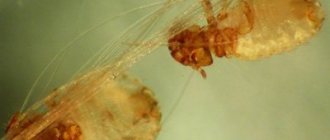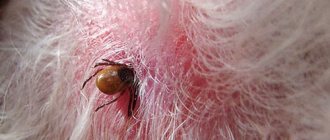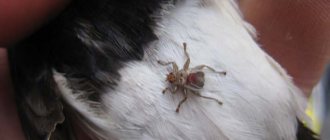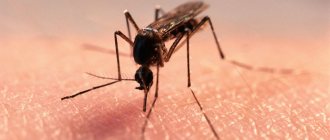Parasitic organisms live at the expense of other creatures, robbing them of useful microelements. Against the background of nutrient deficiency, extensive intoxication occurs with waste products of parasites, therefore, the internal organs of the infected person lose their functionality. In severe and advanced cases, this can lead to death.
Some parasitic diseases of domestic animals pose a serious danger to humans. For this reason, owners should know the main symptoms of the presence of parasites in cats, which depend on the type of pathogen.
Types of parasites in domestic cats
Parasites in cats are divided into internal and external. The former are called endoparasites, and the latter – ectoparasites.
Depending on the location of parasitism, cutaneous and subcutaneous ones are also distinguished. They are external, but affect different layers of the skin. This affects symptoms.
Skin
Representatives of this group live on the outer layer of the epidermis, that is, directly on the skin and in the hairs. The main method of infection is contact. Animals become ill through direct interaction with infected individuals and through contact with their personal belongings (feeders, beds, combs).
Fleas
The most problematic type of ectoparasites are fleas. Depending on their preferred food source, they come in cat, dog, rat and human varieties. The first are record holders for survival in difficult conditions, so most often you have to fight with them.
The size of the flea is no more than 0.5 cm, but after feeding the insect increases in size. It is held on the body by numerous spines and bristles, and uses a piercing-sucking mouthparts to suck blood.
IMPORTANT!
Unlike their counterparts, cat fleas do not disdain other types of blood. They easily change owners and can move to a dog or a person.
Ixodid ticks
Like fleas, these microscopic arthropods also feed on blood. They are also united by the possibility of carrying pathogens of other deadly diseases (helminthiasis, piroplasmosis, borreliosis, encephalitis) in their saliva.
After consuming blood, the tick increases from 0.3-0.4 cm to 1 cm. This makes it easier to detect.
Females cause the most damage. They bite deeper into the skin than males, which is fraught with severe inflammation and sepsis. Maximum activity is observed from the beginning of spring to the end of autumn, in the south of the country - from October-November and until May.
Lice-eating lice
Lice eaters are the smallest ectoparasites with a narrow body and a wide head. Their length is 0.1-0.2 cm. Unlike fleas and ticks, lice eaters do not know how to extract blood on their own and feed on it only from scratching. The rest of the time they eat keratinocytes - hair and skin cells.
Lice eaters also have a longer duration of parasitism. They remain on the owner until the end, which reduces the likelihood of infecting other animals.
Subcutaneous
Subcutaneous parasites in cats include 4 types of ticks. They live in the inner layers of the skin, so to detect them, a scraping must be taken from a sick animal.
Otodectes cynotis
Parasitizes the outer and inner parts of the ear. Causes otodectosis, which is easily identified by a nauseating putrid odor, severe itching and dark specks in the ears. The maximum size of the exciter reaches 0.75 mm.
Notoedres cati
This mite causes pruritic scabies, or notoedrosis. Its body length is 0.5 mm, and its main habitat is the outer part of the ears. Symptoms of the disease include dark gray discharge from the ears and matted hair.
Sarcoptes scabiei
The smallest representatives of this species reach only 0.14 mm in length. They parasitize the entire surface of the body and cause sarcoptic mange. The main symptom of this disease is thin lines of light gray color that appear on the affected areas. A small bubble can be found at their base.
Demodex cati
Despite their similar sizes (0.2-0.3 mm), these mites are classified as opportunistic. They are in the body from birth, but can cause demodicosis with a sharp drop in immunity. They live in hair follicles and sebaceous glands.
Domestic
Feline endoparasites include protozoa, various types of worms (helminths) and blood parasites. Both affect internal organs, but the latter focuses on blood vessels.
Protozoa
This group includes Toxoplasma and Coccidia. The peculiarity of feline toxoplasmosis is that mustachioed pets act as the main hosts, and not intermediate ones. In their body, Toxoplasma goes through the entire development cycle, which contributes to an increase in their number and the severity of the disease. New protozoa are formed by division in infected cells and sexual reproduction in the intestine.
Coccidia in cats is also an intestinal parasite and causes severe dehydration. Because of this, coccidiosis is very difficult for kittens to tolerate. Frequent bouts of vomiting and constant diarrhea lead to a sharp weakening of the immune system, which increases the likelihood of a secondary infection.
Helminths
The routes of infection by worms depend on their type. All existing pathogens can be divided into 3 groups:
- Nematodes (round)
. They enter the body along with contaminated food or through damaged areas of the skin and mucous membranes.
- Trematodes (flat)
. They are widely distributed. Infection occurs when drinking water from fresh water bodies or eating their inhabitants.
- Cestodes (tape)
. The largest representatives, reaching up to 10 m in length. Transmitted through the bites of blood-sucking insects.
The symptoms of helminthiasis depend on the location of the infection. According to this criterion, worms are classified into intestinal, pulmonary, heart and liver.
IMPORTANT!
Lungworms have a long incubation period (up to 6 months). At an early stage of the disease, they can only be detected using special equipment.
Blood parasites
Representatives of this group destroy blood cells. These include:
- Hemobartonella
. Penetrates into red blood cells, causing an autoimmune reaction. An infected organism attacks not only diseased cells, but also healthy cells. Because of this, acute anemia and oxygen starvation develops.
- Pyroplasmas
. Carried by ixodid ticks. Most often found in dogs and also in wild cats. Cases of infection of domestic “whiskers” with piroplasmosis were confirmed by German veterinarians in 2013. The risk group includes Siamese.
- Rickettsia
. Unlike other types, these pathogens penetrate not into red blood cells, but into platelets and lymphocytes. Like piroplasmas, they enter the body through ticks.
The cat family is mainly diagnosed with hemobartonellosis. Cases of piroplasmosis and rickettsiosis (erlichiosis) are very rare, but veterinarians still recommend following basic measures to prevent these diseases.
Signs of roundworms, methods of deworming
The most common cat parasite is roundworms. The whitish worms reproduce in the intestines and can reach 13 centimeters. They usually come out in excrement, with sputum when coughing. If cats have worms:
- loose stools are observed;
- cough appears;
- eyes become dim;
- wool loses its shine;
- Appetite increases greatly.
The kitten's belly may become bloated.
The main means of combating worms are drugs made on the basis of piperazine. The dosage is selected taking into account the weight of the animal and its age. It is necessary to strictly observe hygiene rules and carry out regular preventive measures. Anti-worm medications should be given once a year. Deworming includes 2 procedures with an interval of 10 days.
It is impossible to remove roundworms from a sick animal. In this condition, medications containing piperazine are deadly for your pet. Pregnant and lactating cats are not dewormed.
Symptoms of ectoparasites
The main sign of infection with ectoparasites is a skin reaction. It includes the following symptoms:
- redness;
- inflammation;
- ulcerations;
- suppuration;
- local or total hair loss;
- dandruff;
- severe itching.
Due to constant scratching, the animal's body quickly becomes covered with bloody crusts. Bacteria and other pathogenic organisms easily penetrate into the lesions, complicating the course of the underlying disease.
How to detect?
The most important sign of the presence of this pest in a cat is a dark, almost black, coating in the animal’s ear folds. This color of plaque is explained by the mixing of cat blood, earwax and pathogenic enzymes of the tick itself. It is worth paying close attention to your pet if he periodically shakes his head, trying to squirm away from the annoying ear itch. The localization sites of the parasites become somewhat swollen due to the overcrowding of the ear vessels with blood.
Timely contact with a veterinarian will protect your cat from hearing loss or even death.
Ixodid ticks are the most dangerous type of bloodsuckers, extremely hardy and prolific. This tick is a carrier of many serious diseases. The danger of infection by this species is extremely high, since this parasite has a wide habitat: grass, shrubs and trees, the entire forested area. However, the ixodid pest can also end up in a completely deserted place, on bare ground.
Symptoms of internal parasites in cats
With endoparasites, the symptoms are more varied. They depend on the location of the lesion:
- Intestines. Weight loss, stool disturbances, vomiting and bloating are observed. If the problem lies in helminths, then a prolonged increase in their number can result in organ rupture.
- Lungs. Infection is accompanied by a hoarse cough, difficulty breathing, sneezing and pneumonia.
- Heart. In addition to breathing problems, cramps and fatigue are noted.
- Liver, gallbladder and pancreas. The main symptom is yellowing of the skin and mucous membranes. Abdominal pain and deterioration in coat quality are also possible.
With massive death of blood cells, anemia develops. It is characterized by pale or blue discoloration of mucous membranes, decreased body temperature, dilated pupils, rapid heartbeat and loss of consciousness.
NOTE!
With advanced helminthiasis, the worms come out along with feces and vomit. These symptoms require immediate veterinary attention, as otherwise the animal may die from intoxication.
Pathogens
Dogs are most often parasitized by canine, cat and human fleas. Adult insects are wingless, the body is strongly compressed laterally, the legs are strong, long, with numerous spines, the antennae are short, club-shaped, hidden at rest in recesses on the sides of the head. The mouthparts are adapted for piercing the skin and sucking blood. Fleas are small insects with a body usually not exceeding 2-4 mm in length.
The pathogen has ctenidia on the lower edge of the head and on the posterior edge of the anterior thoracic segment (a row of spines in the form of a comb-like formation with points directed backwards), consisting of 7-9 spines, with the first spine in the head row and the lower spine in the thoracic row of the ctenidium being shorter than the others .
Biology
Fleas are temporary parasites. Female fleas lay very small, oval, whitish eggs, dropping them (non-sticky eggs) onto the host, from where they can roll onto the litter, ground, or floor. After 1-2 weeks, under favorable conditions, larvae with a thin worm-like body emerge from the eggs, leading a free lifestyle and feeding on decaying organic matter and food residues. After a few days, the larvae pupate in a cocoon. After 12 days, an adult flea emerges from the pupa, leading a parasitic lifestyle.
Males and females suck blood. Capable of long-term fasting (up to 18 months) outside the host’s body.
Parasites in kittens
Due to their weak immunity, kittens are at risk both in terms of the likelihood of infection and the severity of parasitosis. Their body is not adapted to prolonged dehydration, so without outside intervention, many babies die within the first two days.
Another problem concerns treatment. Antiparasitic agents are toxic, so ideally they should only be used for prophylaxis at regular intervals. The first pills are given to babies only 3 weeks after birth, and until this point, veterinarians recommend strict quarantine.
Intoxication is harmful not only for kittens, but also for pregnant cats. For this reason, animals must be dewormed before mating.
Coccidia and toxoplasma
Coccidia are single-celled parasites that penetrate the epithelial surface. They multiply directly in tissue cells, which leads to their destruction. A cat becomes infected from other individuals carrying the pathogen. When coccidia appear:
- there is regular diarrhea;
- blood appears in the feces;
- weight is lost and exhaustion sets in.
Veterinarians have drugs in their arsenal that destroy these parasites. It is important to strictly follow hygiene rules and destroy cat litter by burning it.
A special type of coccidia is Toxoplasma. These parasites destroy the tissue of the visual organs, lymph nodes, and brain. For cats, this type of parasite is considered natural; in small quantities they do not threaten the animal’s body. But infection with toxoplasma is extremely dangerous for pregnant women. These parasites can cause abnormalities in the fetus.
What to do if cats are infected with parasites
Treatment options for cat parasites depend on the type of parasite, the age of the animal, and the severity of the disease. The main emphasis is on destroying the pathogen. Additional measures include relieving associated symptoms, a therapeutic diet, and external treatment of skin lesions.
Why is diagnosis by a veterinarian so important?
All the described symptoms are non-specific. They are characteristic not only of parasitic diseases, but also of systemic ones. In the latter case, treatment with antiparasitic drugs will not only not give the desired result, but will also aggravate the course of the disease due to increased intoxication.
We also must not forget about the danger of infecting others. Many of the described pathogens are transmitted to humans, so at least basic safety measures should be observed before making a diagnosis.
In addition to the external examination, diagnosis at the veterinary clinic includes the following studies:
- stool, blood and urine tests to detect helminth eggs and disturbances in the systemic blood flow;
- skin scrapings to determine the type of ectoparasite;
- light microscopy, revealing changes in the contour and color of red blood cells;
- smears and swabs from mucous membranes where toxoplasma lives;
- Ultrasound and x-rays assessing the general condition of internal organs.
Based on the data obtained, the veterinarian draws up an individual treatment plan. The duration of taking medications depends on the results of new tests, and until this point it is not recommended to deviate from the prescribed regimen.
Destruction of pathogens
Antiparasitic drugs are available in several forms. These include:
- Collars
. Repels ectoparasites. They are effective only as a preventive measure and often cause allergies.
- Shampoos
. Suitable for treatment and have hypoallergenic properties. The problem with using them is that very few cats like water treatments.
- Drops on the withers
. They are applied along the spinal column and destroy the pathogen in a short period. May provoke an allergic reaction.
- Sprays
. Basically they protect only the fur, that is, they are more suitable for prevention. Can be used not only on animals, but also on various surfaces.
- Pills
. They have the most powerful and long-lasting effect, but they are quite problematic to feed to a cat.
- Suspensions and pastes
. Unlike tablets, they have a more pleasant consistency and aroma. Suitable for treating kittens and capricious pets.
In addition to the listed remedies, the veterinarian may recommend antihistamines, hepatoprotectors, glucocorticosteroids, diuretics, antidiarrheals, antiemetics and probiotics. Their main task is to relieve associated symptoms and improve the functioning of the affected organs.
IMPORTANT!
Animals in serious condition are treated in a hospital with the help of droppers and oxygen chambers.
Additional measures, care and diet
Additional measures include treating the premises and the pet’s wounds. The patient’s personal belongings are boiled or thrown away, and all surfaces are treated with insecticidal sprays or soda solution.
When caring for an infected pet, it is important to remember to wash your hands after each contact. It is advisable to use rubber gloves. Until recovery, it is recommended to keep the cat in a separate room, preventing communication with other pets.
The therapeutic diet is prescribed individually, but in most cases it requires adherence to the following rules:
- Fractional meals. Small but frequent portions reduce the load on the gastrointestinal tract and facilitate the absorption of food.
- Focus on low-calorie but filling foods: chicken, turkey, cottage cheese.
When dry feeding, use medicated feed from a familiar manufacturer. This eliminates long-term addiction through gastrointestinal disorders.
Nematodes
This type of internal parasite is less common than roundworms, but can cause equally serious health problems. There are practically no symptoms at the initial stage of infection, which makes it difficult to make a timely diagnosis. Manifestations of an advanced form of the disease are diarrhea, blood in the stool, and weight loss of the animal. Nematodes are transmitted through infected animals and the ingestion of infectious eggs and larvae. A pregnant cat infected with nematodes can pass the infection to her unborn kittens.
It is necessary to carry out mandatory preventive treatment of the animal with anthelmintic drugs, since parasites in cats that are transmitted to humans through normal contact can cause serious diseases, especially in children.
What parasites pose a danger to humans?
Of the ecto- and endoparasites considered, you should be wary of fleas, ixodid ticks, toxoplasma and helminths. All of them, except toxoplasma, are transmitted by contact.
You can become infected with toxoplasmosis only during the removal of feces, and the disease itself is generally mild. Complications develop only with weakened immunity, so the risk group includes pregnant women, children under 3 years of age and the elderly.
Subcutaneous parasites and lice eaters are not dangerous to humans, since their mouthparts are not adapted for gnawing through our skin. They are also not happy with their lower body temperature compared to cats. In the worst case scenario, you will end up with bites and redness. The exception is sarcoptic mange (scabies).
Hemobartonellosis is an exclusively feline disease, so it is not transmitted to people or dogs. Transmission of other blood parasites is possible only through ticks. Also, do not be afraid of coccidia.
ADVICE!
Do not let your pet lick wounds on your skin until he gets better, and treat your hands with antiseptic or regular soap after each contact.
Can lice pass from a cat to a person?
No, insects from a cat's fur do not pass on to humans. This is due to the structural features of insects. A person's body temperature is lower, so even if several parasites are specially transferred, they will not be able to live on a person's head.
Can lice pass from a cat to a person?
Treatment of the disease
Symptoms manifest themselves in the form of general weakness of the animal and anemia. When treating hookworm disease, it is better to use the drug Mebenvet. No less effective remedies for this disease are Fenbendazole and Pyrantel.
Dipylidiasis is an infection with cucumber tapeworm. This bright representative of the genus of tapeworms received its name due to its external resemblance to cucumber grain. The main habitat of the helminth is the small intestine. The cat may not have any obvious symptoms of tapeworm in the intestines. Most often, homeless individuals who are in close contact with insects, which are the main carriers of the cucumber tapeworm, are infected.











